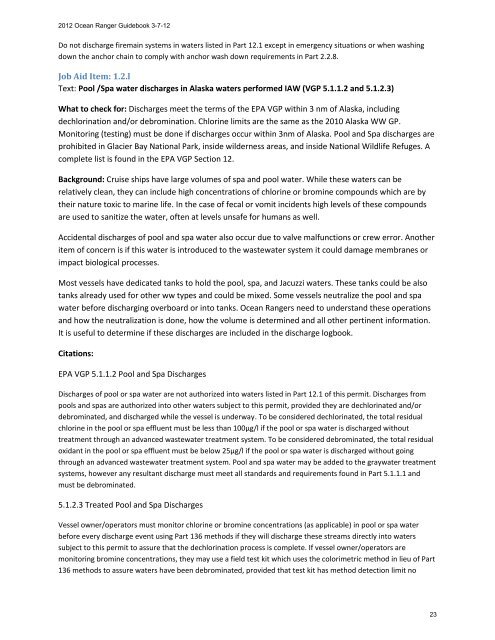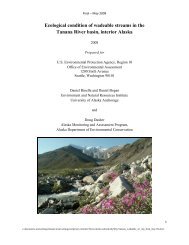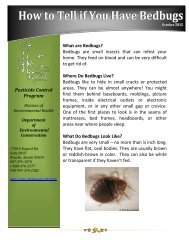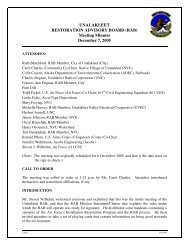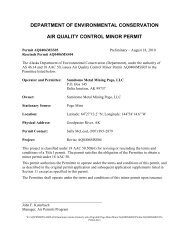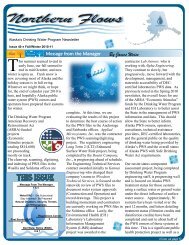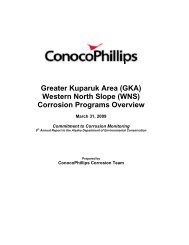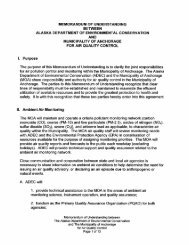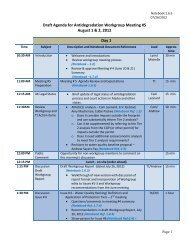2012 Ocean Ranger Guidebook Revision 3-7-12 - Alaska ...
2012 Ocean Ranger Guidebook Revision 3-7-12 - Alaska ...
2012 Ocean Ranger Guidebook Revision 3-7-12 - Alaska ...
You also want an ePaper? Increase the reach of your titles
YUMPU automatically turns print PDFs into web optimized ePapers that Google loves.
<strong>20<strong>12</strong></strong> <strong>Ocean</strong> <strong>Ranger</strong> <strong>Guidebook</strong> 3-7-<strong>12</strong><br />
Do not discharge firemain systems in waters listed in Part <strong>12</strong>.1 except in emergency situations or when washing<br />
down the anchor chain to comply with anchor wash down requirements in Part 2.2.8.<br />
Job Aid Item: 1.2.l<br />
Text: Pool /Spa water discharges in <strong>Alaska</strong> waters performed IAW (VGP 5.1.1.2 and 5.1.2.3)<br />
What to check for: Discharges meet the terms of the EPA VGP within 3 nm of <strong>Alaska</strong>, including<br />
dechlorination and/or debromination. Chlorine limits are the same as the 2010 <strong>Alaska</strong> WW GP.<br />
Monitoring (testing) must be done if discharges occur within 3nm of <strong>Alaska</strong>. Pool and Spa discharges are<br />
prohibited in Glacier Bay National Park, inside wilderness areas, and inside National Wildlife Refuges. A<br />
complete list is found in the EPA VGP Section <strong>12</strong>.<br />
Background: Cruise ships have large volumes of spa and pool water. While these waters can be<br />
relatively clean, they can include high concentrations of chlorine or bromine compounds which are by<br />
their nature toxic to marine life. In the case of fecal or vomit incidents high levels of these compounds<br />
are used to sanitize the water, often at levels unsafe for humans as well.<br />
Accidental discharges of pool and spa water also occur due to valve malfunctions or crew error. Another<br />
item of concern is if this water is introduced to the wastewater system it could damage membranes or<br />
impact biological processes.<br />
Most vessels have dedicated tanks to hold the pool, spa, and Jacuzzi waters. These tanks could be also<br />
tanks already used for other ww types and could be mixed. Some vessels neutralize the pool and spa<br />
water before discharging overboard or into tanks. <strong>Ocean</strong> <strong>Ranger</strong>s need to understand these operations<br />
and how the neutralization is done, how the volume is determined and all other pertinent information.<br />
It is useful to determine if these discharges are included in the discharge logbook.<br />
Citations:<br />
EPA VGP 5.1.1.2 Pool and Spa Discharges<br />
Discharges of pool or spa water are not authorized into waters listed in Part <strong>12</strong>.1 of this permit. Discharges from<br />
pools and spas are authorized into other waters subject to this permit, provided they are dechlorinated and/or<br />
debrominated, and discharged while the vessel is underway. To be considered dechlorinated, the total residual<br />
chlorine in the pool or spa effluent must be less than 100μg/l if the pool or spa water is discharged without<br />
treatment through an advanced wastewater treatment system. To be considered debrominated, the total residual<br />
oxidant in the pool or spa effluent must be below 25μg/l if the pool or spa water is discharged without going<br />
through an advanced wastewater treatment system. Pool and spa water may be added to the graywater treatment<br />
systems, however any resultant discharge must meet all standards and requirements found in Part 5.1.1.1 and<br />
must be debrominated.<br />
5.1.2.3 Treated Pool and Spa Discharges<br />
Vessel owner/operators must monitor chlorine or bromine concentrations (as applicable) in pool or spa water<br />
before every discharge event using Part 136 methods if they will discharge these streams directly into waters<br />
subject to this permit to assure that the dechlorination process is complete. If vessel owner/operators are<br />
monitoring bromine concentrations, they may use a field test kit which uses the colorimetric method in lieu of Part<br />
136 methods to assure waters have been debrominated, provided that test kit has method detection limit no<br />
23


